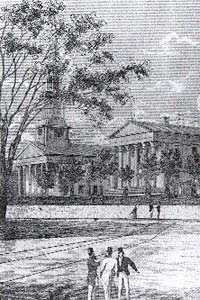Why Worcester?
“Why Worcester?” is the most common question people ask when they learn about this city’s leadership role in the history of radical social reform. Like many other communities in the early nineteenth century, Worcester encountered a surge of new ideas at the onset of the industrial revolution. Economic growth, coupled with a heartfelt theology that stressed human free will, inspired a keenly felt desire for a new social order. The generation that came of age in the two decades before the Civil War believed that they had the ability to reorder virtually every aspect of society from as personal as one’s own hygiene to redefining the meaning of human rights. Campaigns against drunkenness, capital punishment, and slavery, on the one hand, or for women’s rights, dress reform, and a ten-hour work day, on the other, existed alongside a proliferation of new religions and utopian communities. In this period, even the human body was reinterpreted as new methods to read it, treat it, or feed it—such as phrenology, hydropathy, and the Graham diet—emerged.
During these years, however, Worcester experienced an even greater transformation than many other locations. Extensive stage, canal, and railroad lines allowed people and goods to get here quickly and easily. The Blackstone Canal opened in 1828; the first railroad arrived in 1835; and by 1850, six railroads passed through the city and twenty-four trains arrived and departed each day. The population exploded. By 1820, Worcester had become the largest town in the county, and it continued to grow. By 1850, its population had increased fivefold. Manufacturing had become the city’s dominant enterprise by then, and its metal industries gained national prominence. Worcester’s highly skilled labor force led the country in mechanical invention and design. In 1855, an article in the Massachusetts Spy noted that the number of patents granted to Worcester residents exceeded, by proportion, those of any other city. By 1860, Worcester was home to 170 manufacturing establishments; indeed, that year its wire mills turned out 58% of all wire produced in America. By the last third of the nineteenth century, Worcester had become a major industrial center—second only to Boston in Massachusetts, and the 28th largest such center in the entire United States.
But Worcester was known for more than its manufacturing. The city’s growth promoted a rich cultural life, and it had the economic means to build the halls, hotels, and various institutions necessary to host speakers and events. The Worcester Lyceum and the Mechanics Association sponsored a lively lecture series that included notable speakers addressing all the pressing issues of the day. In 1853, “Stella,” a columnist for the Palladium newspaper, wrote that “Our citizens are lecture crazy!” (Chasan, 166). A vast assortment of panoramas, tableaux, exhibitions, fairs, conventions, and concerts could be seen in Worcester at any given time. The city was known for its ability to attract and host large gatherings. “Another Convention at Worcester!” Christopher Columbus Baldwin, a lawyer, and the librarian of the American Antiquarian Society, recorded in his diary in 1833. In 1850, the National Aegis newspaper expressed the same sentiment: “The Whigs, Democrats, Free-Democrats, Land Reformers, Come-Outers and Disunionists have already held their respective Conventions for the season, and most of them in this city.”
As a result, Worcester citizens pondered, debated, and discussed the latest reform issues. Among all of those issues, however, Worcester and Worcester County particularly supported radical abolitionism and women’s rights. Two of the nation’s most radical (and often despised) abolitionists, Abby Kelley Foster and her husband Stephen S. Foster, adopted Worcester as their home, as did Thomas Wentworth Higginson and Edward Everett Hale. The area was already home to Lucy Stone, Eli Thayer, and Samuel May, Jr. They were joined in their political activities by networks of related Quaker families such as the Earles and the Chases, whose organizing efforts were crucial to the anti-slavery cause in central Massachusetts and throughout New England.
In the 1830s, hundreds of Worcester County abolitionists were members of either the North or the South Division Anti-Slavery Societies, two prominent local abolitionist organizations which were part of the radical American Anti-Slavery Society formed by William Lloyd Garrision. These two societies, which met at least four times a year, remained in existence until the Civil War. Their members advocated, among other things, the immediate abolition of slavery and the separation of Massachusetts from the Union and from all pro-slavery religious or political organizations. Such abolitionists believed that slavery was a sin; they were morally opposed to it, and advocated a position or strategy referred to as “moral suasion,” meaning that societal change would result from changes in the conscience of individuals. They did not look to any institution—religious, political, or civil—for reform. Indeed, they attacked most institutions as fundamentally pro-slavery. Included in the societies’ records, for example, are resolutions against the Northern prejudice they saw toward the condition of free blacks. All of the nation’s leading abolitionists spoke in central Massachusetts at meetings of the North and South County Division Anti-Slavery Societies, including Garrison, Sarah and Angelina Grimké, Frederick Douglass, William Wells Brown, Sojourner Truth, Harriet Tubman, William and Ellen Craft, Wendell Phillips, Parker Pillsbury, Sallie Holley, Lewis Hayden, John Collins, and others.
Other Worcester County residents, however, opposed slavery without necessarily believing that it was morally wrong. Such citizens—who resisted the extension of slaveholding to the territories and sought a political solution to the problem—gave their support to the Liberty, Free Soil, and Republican Parties. Worcester County, in fact, was the only Free Soil county in Massachusetts and one of only three Free Soil counties in the entire Northeast. In 1854, the Republican Party of Massachusetts was formed here. These parties’ political opposition to the extension of slavery, combined with the radical agitation of the abolitionists, led one observer to remark that Worcester was known as one of the most anti-slavery communities in America.
In 1840, Abby Kelley became the first woman ever elected to a position in the American Anti-Slavery Society. Because her election angered many abolitionists who did not want women in positions of authority, it resulted in the formation of a new organization, the American and Foreign Anti-Slavery Society. Those who remained in the old organization, with Garrison, widened their reform agenda to include women’s rights. Worcester’s North and South County Anti-Slavery Societies followed Garrison’s lead, and soon women from all over Worcester county were elected to all positions within the Society except that of president.
Women learned critical fundraising, speaking, and organizational skills while agitating for the abolition of slavery. Many applied these same skills to their work for women’s rights. Some local women also created institutions and formed societies to address social ills such as poverty and intemperance. The most daring of these women went on to participate in the first and second National Woman’s Rights Conventions, held here in 1850 and 1851.
The first National Woman’s Rights Convention, in 1850, was significant for a number of reasons. It marked the beginning of the organized movement for women’s rights and called for the total reorganization of “all social, political, industrial interests and institutions.” The convention elected officers who were appointed to committees on education, civil and political rights, social relations, and avocations. Its final resolution, which called for “Equality before the law without distinction of sex or color,” was highly controversial because of its shocking support of equality for black women. The convention was applauded by a few local and national newspapers, but disparaged by most of them. The issues raised at the convention, however, were heard throughout the world. It became a touchstone for international feminism, inspiring coverage and essays in France, England, and Germany. Jeanne Deroin and Pauline Roland, two French socialist-feminists who were imprisoned in Paris for their political activities, praised the brave efforts of Worcester’s women in a letter to the second National Woman’s Rights Convention in 1851. Addressing the “Convention of the Women of America,” they proclaimed: “your socialist sisters of France are united with you in the vindication of the right of Woman to civil and political equality” (Anderson, 8).
The issues raised at the 1850 and 1851 Conventions created a forum for subsequent debate concerning the state constitution. Significantly, some of the same women and men who addressed such issues as suffrage, education, property rights, and wages at the Worcester Woman’s Rights Conventions went on to petition the Massachusetts Constitutional Convention in 1853. They asked that the word “male” be stricken from the Constitution; that women be allowed to vote on the amendments; and that greater opportunities be provided for women’s higher education. Four of the five men who were Worcester delegates to the State Constitutional Convention were well known abolitionists who also championed women’s rights and higher education. One recent historian notes that Worcester County led the state in advocating constitutional reform (Brooke, 383). Worcester County voted almost two to one in favor of the constitutional amendments, although its citizens were outvoted across the state. Two years later, in 1855, a law was passed in Massachusetts that allowed women to keep their property after marriage. In the same year, Massachusetts became the first state in the country that permitted women to keep their own wages (Isenberg, 174).
The spirit of national reform that crystallized in Worcester in the mid-nineteenth century, and which led to the 1850 and 1851 National Woman’s Rights Conventions, thus helped to bring about immediate changes in women’s legal status in the state of Massachusetts. It led to other sweeping changes as well: the Emancipation Proclamation, which abolished slavery in America; the Fifteenth Amendment, which gave African-American men the right to vote; and the Nineteenth Amendment, which extended that same right to women. Over 150 years later, however, the historic struggle for “equality before the law without distinction of sex or color” continues. There are still lessons to be learned from the places in Worcester, Massachusetts where that struggle began, and from its great leaders, individual foot soldiers, and entire families who spent their lives here in the pursuit of justice and equality.
Joshua S. Chasan, “Civilizing Worcester: The Creation of Institutional and Cultural Order, Worcester, Massachusetts, 1846–1876,” Ph.D. dissertation, University of Pittsburgh, 1974; Diary of Christopher Columbus Baldwin 1829–1835 (Worcester, MA: Charles Hamilton, 1901), p. 235.; Roy Rosenzweig, Eight Hours for What We Will: Workers & Leisure in an Industrial City, 1870–1920 (New York: Cambridge University Press, 1993); National Aegis, October 23, 1850; Massachusetts Spy, May 25, 1853 and September 9, 1855; “Records of the North and South Division Anti-Slavery Society,” Worcester Historical Museum; Bonnie S. Anderson, Joyous Greetings: The First International Women’s Movement, 1830–1860 (New York: Oxford University Press, 2000); Documents of the Constitutional Convention of the Commonwealth of Massachusetts, During the Session (Boston, 1853); John L. Brooke, The Heart of the Commonwealth: Society and Political Culture in Worcester County, Massachusetts, 1713–1861(Amherst: University of Massachusetts Press, 1989); Nancy Isenberg, Sex and Citizenship in Antebellum America (Chapel Hill: University of North Carolina Press, 1998).


 Excerpt from Worcester
Women's Heritage Trail, by Jessie M. Rodrique, Ph.D., published by the Worcester Women's History Project,
2002.
Excerpt from Worcester
Women's Heritage Trail, by Jessie M. Rodrique, Ph.D., published by the Worcester Women's History Project,
2002.